Homocysteine normal range. Homocysteine Levels: Understanding Normal Range, Risks, and Treatments
What is the normal range for homocysteine levels. How do elevated homocysteine levels impact health. What are the risks associated with high homocysteine. How can homocysteine levels be tested and treated.
The Significance of Homocysteine in Health and Disease
Homocysteine, a sulfur-containing amino acid, has emerged as a critical biomarker in assessing various health risks. Once overlooked, it now commands attention in medical circles due to its far-reaching implications for cardiovascular health, cognitive function, and overall well-being.
Elevated homocysteine levels, known as hyperhomocysteinemia, can serve as an early warning sign for a range of health issues. Understanding the normal range, risks, and treatment options for homocysteine levels is crucial for maintaining optimal health and preventing potential complications.
Defining Normal and Elevated Homocysteine Levels
The definition of “normal” homocysteine levels has evolved over time as research has uncovered more about its impact on health. Historically, hyperhomocysteinemia was defined as levels above 15 μmol/L, with further classifications for moderate (16-30 μmol/L), intermediate (31-100 μmol/L), and severe (above 100 μmol/L) elevations.

However, recent research suggests that lower thresholds may be more appropriate for identifying potential health risks. Many experts now consider levels at or above 10 μmol/L to be indicative of hyperhomocysteinemia and worthy of further investigation.
Current Laboratory Reference Ranges
Despite advances in research, many laboratory reference ranges have not yet caught up with the latest findings. Some labs still consider homocysteine levels up to 21.3 μmol/L as “normal” for individuals over 80 years of age. This discrepancy between research findings and clinical practice highlights the importance of staying informed about the latest developments in homocysteine research.
Health Risks Associated with Elevated Homocysteine
Elevated homocysteine levels have been linked to a variety of health concerns, ranging from cardiovascular issues to cognitive decline. Understanding these risks is essential for both patients and healthcare providers.
Cardiovascular Health
Homocysteine has been identified as an independent risk factor for atherosclerosis, affecting cerebral, coronary, and peripheral arteries. Even levels previously considered “normal” (around 10.5 μmol/L) have been associated with atherosclerotic regions in the carotid arteries of otherwise healthy individuals.
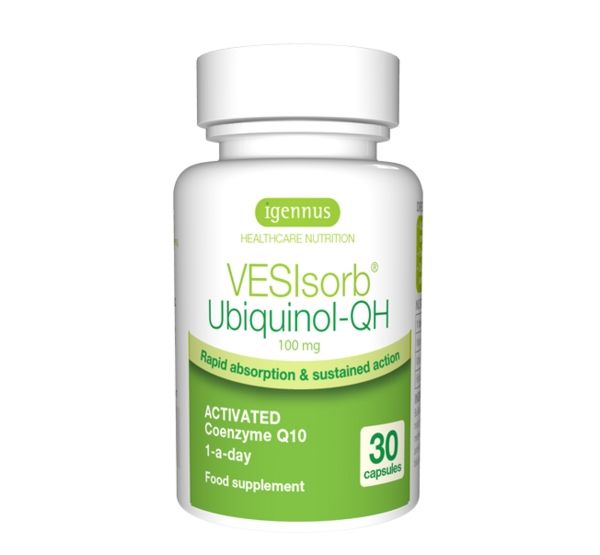
Is there a direct link between homocysteine and cardiovascular events? Studies have shown that homocysteine levels above 9.47 μmol/L are associated with an increased risk of cardiovascular events. Additionally, levels exceeding 15 μmol/L have been found to significantly predict such events.
Cognitive Function
Homocysteine levels play a crucial role in cognitive health. Research has shown that when homocysteine rises above 11 μmol/L, there is a significant decline in cognitive function. At levels of 20 μmol/L, the risk of cognitive decline increases by 88%. These findings have led researchers to conclude that elevated homocysteine is a strong modifiable risk factor for vascular dementia and Alzheimer’s disease.
Other Health Concerns
- Inflammation: Homocysteine levels above 10 μmol/L have been significantly associated with elevated C-reactive protein (CRP), a marker of inflammation.
- Liver function: Elevated homocysteine has been linked to increased levels of aspartate aminotransferase (AST), an indicator of liver health.
- Kidney function: Higher homocysteine levels correlate with increased urea and creatinine, which may reflect impaired kidney function.
- Vitamin D status: An inverse relationship has been observed between homocysteine levels and 25(OH) vitamin D concentrations.
Factors Influencing Homocysteine Levels
Several factors can influence homocysteine levels in the body. Understanding these factors is crucial for interpreting test results and developing effective treatment strategies.
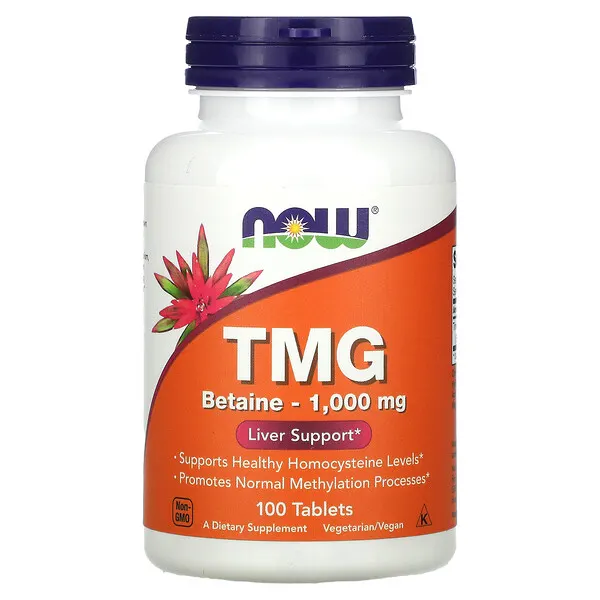
Nutritional Factors
Vitamins B6, B12, and folate play a vital role in homocysteine metabolism. Deficiencies in these vitamins can lead to elevated homocysteine levels. Ensuring adequate intake of these nutrients through diet or supplementation is essential for maintaining optimal homocysteine levels.
Lifestyle Factors
Sleep duration has been linked to homocysteine levels, with shorter sleep duration associated with higher homocysteine concentrations. Specifically, levels above 9.74 μmol/L have been associated with reduced sleep duration, which is itself a potential cardiovascular risk factor.
Metabolic Factors
Various metabolic factors have been associated with homocysteine levels:
- Body Mass Index (BMI) and waist circumference
- Blood pressure
- Lipid profile (LDL-C, HDL-C, triglycerides)
- Uric acid levels
- Blood glucose concentrations
These associations suggest that homocysteine levels may be influenced by, or contribute to, overall metabolic health.
Testing for Homocysteine Levels
Given the importance of homocysteine in assessing health risks, testing for homocysteine levels has become increasingly common. How is homocysteine testing performed?

Homocysteine testing typically involves a blood draw, with the sample analyzed in a laboratory setting. Fasting before the test is usually recommended to ensure accurate results. The test measures the total homocysteine concentration in the blood, including both free and protein-bound forms.
Interpreting Test Results
When interpreting homocysteine test results, it’s important to consider the latest research findings rather than relying solely on laboratory reference ranges. Based on current evidence, the following guidelines can be useful:
- Optimal: Below 9 μmol/L
- Borderline: 9-10 μmol/L
- Elevated: Above 10 μmol/L
- High: Above 15 μmol/L
However, it’s crucial to interpret these results in the context of an individual’s overall health status and risk factors.
Strategies for Lowering Homocysteine Levels
For individuals with elevated homocysteine levels, several strategies can be employed to bring levels back into the optimal range. What are the most effective approaches for lowering homocysteine?

Nutritional Interventions
Ensuring adequate intake of B vitamins is crucial for maintaining healthy homocysteine levels. This can be achieved through dietary modifications or supplementation:
- Folate: Found in leafy green vegetables, legumes, and fortified grains
- Vitamin B6: Present in poultry, fish, potatoes, and non-citrus fruits
- Vitamin B12: Abundant in animal products, particularly meat and dairy
In some cases, supplementation may be necessary, particularly for individuals with absorption issues or those following restrictive diets.
Lifestyle Modifications
Several lifestyle changes can contribute to lower homocysteine levels:
- Regular exercise: Physical activity has been shown to help reduce homocysteine levels
- Stress reduction: Chronic stress may contribute to elevated homocysteine
- Smoking cessation: Smoking is associated with higher homocysteine levels
- Moderate alcohol consumption: Excessive alcohol intake can increase homocysteine
Addressing Underlying Health Issues
In some cases, elevated homocysteine may be a symptom of underlying health conditions. Addressing these issues can help normalize homocysteine levels:
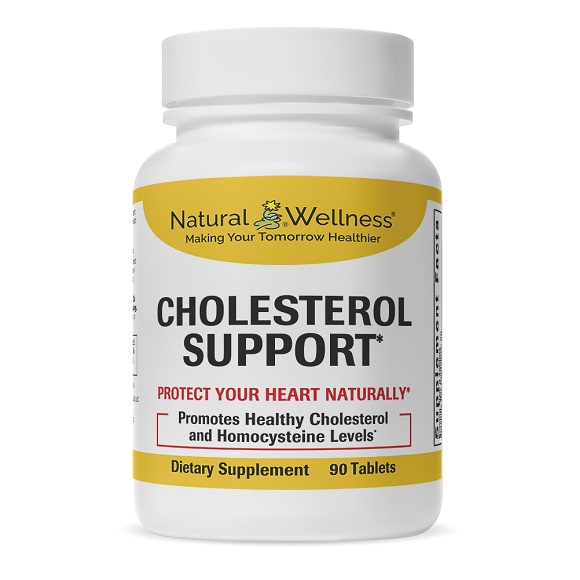
- Thyroid dysfunction
- Kidney disease
- Certain medications (e.g., methotrexate, anticonvulsants)
Working with a healthcare provider to identify and treat any underlying conditions is crucial for long-term management of homocysteine levels.
The Role of Homocysteine in Preventive Health
As our understanding of homocysteine’s impact on health continues to grow, its role in preventive medicine becomes increasingly clear. How can monitoring homocysteine levels contribute to overall health and disease prevention?
Regular monitoring of homocysteine levels, particularly in individuals with risk factors for cardiovascular disease or cognitive decline, can provide valuable insights into overall health status. By identifying elevated levels early, interventions can be implemented to potentially prevent or delay the onset of serious health conditions.
Personalized Risk Assessment
Homocysteine levels can be used in conjunction with other biomarkers to create a more comprehensive picture of an individual’s health risks. This personalized approach allows for tailored prevention strategies and early interventions.

Monitoring Treatment Efficacy
For individuals undergoing treatment for elevated homocysteine, regular testing can help assess the effectiveness of interventions. This allows for timely adjustments to treatment plans as needed.
Future Directions in Homocysteine Research
As research into homocysteine continues, new insights and applications are likely to emerge. What are some potential areas for future investigation?
- Genetic factors: Further exploration of genetic variations that influence homocysteine metabolism
- Novel interventions: Development of new strategies for lowering homocysteine levels
- Long-term outcomes: Continued study of the long-term health impacts of maintaining optimal homocysteine levels
- Interaction with other biomarkers: Investigation of how homocysteine interacts with other health indicators to influence disease risk
As our understanding of homocysteine’s role in health and disease continues to evolve, it’s likely that its importance in preventive medicine and personalized healthcare will only grow.

Homocysteine: Highs, Lows, and Optimals
In this post, the ODX Research team dives into homocysteine, a silent but deadly biomarker, and provides research-based evidence to a tighter optimal reference range.
Homocysteine: Highs, Lows, and Optimals
Dicken Weatherby, N.D. and Beth Ellen DiLuglio, MS, RDN, LDN
Elevated homocysteine (Hcy) has been recognized as a risk factor for cardiovascular disease considering its negative effects on vascular endothelial integrity and its promotion of oxidative stress.[1] It is an independent risk factor for atherosclerosis (cerebral, coronary, and peripheral) so excess homocysteine can have harmful consequences throughout the body.[2] Renal impairment may contribute to higher homocysteine levels due to reduced excretion. Therefore, kidney function should be evaluated when investigating increased homocysteine.
Acceptable levels of Homocysteine have varied over time. In the past, hyperhomocysteinemia, elevated levels of homocysteine in the blood, had been defined as a level above 15 umol/L, with moderate hyperhomocysteinemia being defined as 16-30 umol/L, intermediate 31-100 umol/L, and severe hyperhomocysteinemia above 100 umol/L. [3] However, researchers now recognize that a level of 10 umol/L or above can be considered hyperhomocysteinemia and warrants further assessment. [4]
[3] However, researchers now recognize that a level of 10 umol/L or above can be considered hyperhomocysteinemia and warrants further assessment. [4]
Unfortunately, again, research does not quickly translate into updated lab reference ranges. Even today, “normal” lab values for the homocysteine range can from 0 to a high of 21.3 umol/L for individuals over 80 years of age.[5]
However, a significant decline in cognitive function was observed when Hcy rose above 11 umol/L, with an 88% increased risk of decline with Hcy of 20 umol/L. Researchers conclude that elevated homocysteine is a “strong modifiable risk factor for vascular dementia and Alzheimer’s.”[6]
Higher than optimal homocysteine has been associated with a variety of negative health outcomes.
Levels of homocysteine previously accepted as “normal” with a mean of 10.5 umol/L, were associated with atherosclerotic regions in the carotid arteries of healthy individuals.[7] Atherosclerosis of the carotid artery is considered a strong predictor for stroke and cardiovascular disease. [8]
[8]
In a randomized double-blind placebo-controlled trial of overweight women with vitamin D deficiency, homocysteine levels greater than 10 umol/L were significantly associated with elevated CRP, AST, urea, and creatinine, as well as decreased 25(OH) vitamin D.[9]
In a study of 396 individuals with an average age of 64, homocysteine was considered an independent risk factor for CVD. Levels positively correlated with LDL-C, uric acid, BMI, waist circumference, and blood pressure, and negatively correlated with HDL-C. Homocysteine below 11 umol/L was considered low, and above 14.3 umol/L was considered high in the study.[10]
A tighter range for cutoff values may help predict the risk of cardiovascular morbidity and mortality. Higher homocysteine was also associated with shorter sleep duration, a potential cardiovascular risk factor. Note Hcy cutoff values from various studies:[11]
- 9.47 umol/L for cardiovascular events
- 9.74 umol/L associated with short sleep duration
- 11.
 84 umol/L for all-cause death
84 umol/L for all-cause death - > 15 umol/L significantly predicted cardiovascular events
Along with vitamin B6 deficiency, elevated hs-CRP, elevated IL-6, and shortened telomeres, Hcy is considered a marker of oxidative stress and systemic inflammation and contributes to morbidity and mortality. Homocysteine levels of 9.8 umol/L or higher were associated with a 28% greater risk of all-cause mortality, including CVD when compared to those with concentrations below 9.8 umol/L.[12]
A study of 4177 subjects with prehypertension (SBP 120-139 mmHg, DBP 80-89 mmHg) demonstrated an independent association between homocysteine levels and arterial stiffness. Quartiles of Hcy were defined: ≤9.19; 9.20–10.86; 10.87–12.79; and ≥12.80 umol/L.[13]
Brachial-ankle pulse wave velocity, a marker for arterial stiffness, increased progressively as Hcy increased, suggesting an increased risk of progression from prehypertension to hypertension. BMI, waist circumference, serum glucose, uric acid, triglycerides, HDL, and LDL cholesterol differed significantly between quartiles as well.
Data analyzed from the NHANES III studies suggest that when the highest and lowest quintiles of homocysteine were compared (11.5 – 98.1 versus 3 – 6.4 umol/L), the risk of hypertension increased twofold for men and threefold for women with higher Hcy.[14] Researchers note that the sufficiency of vitamins B6, B12, and folate can influence homocysteine and blood pressure levels.
As we can see from a variety of studies, as homocysteine begins to increase above 9 umol/L, disease risk increases as well. It is important to closely monitor and intervene in those trending toward dysfunction before the disease begins to manifest.
We must not demonize homocysteine completely as it is important as a sulfur depot and a methyl transfer molecule. Low or insufficient homocysteine should be addressed as it may reflect a compromised ability to synthesize glutathione, which will increase the risk of oxidative stress. Low homocysteine may also be associated with peripheral neuropathy.[15]
Researchers have observed a U-shaped curve with regard to homocysteine and elevated blood pressure. The risk of hypertension appeared to increase with increasing homocysteine, but risk also appeared to increase with lower homocysteine, especially in males.[16]
The risk of hypertension appeared to increase with increasing homocysteine, but risk also appeared to increase with lower homocysteine, especially in males.[16]
According to Mosby’s guidelines, a homocysteine below 4 umol/L would be considered low.[17]
An optimal goal for homocysteine would be ~ 5 – 7.2 umol/L.
RESEARCH
[1] Ganguly, Paul, and Sreyoshi Fatima Alam. “Role of homocysteine in the development of cardiovascular disease.” Nutrition journal vol. 14 6. 10 Jan. 2015, doi:10.1186/1475-2891-14-6
[2] Kumar, Avinash et al. “The metabolism and significance of homocysteine in nutrition and health.” Nutrition & metabolism vol. 14 78. 22 Dec. 2017, doi:10.1186/s12986-017-0233-z
[3] Ganguly, Paul, and Sreyoshi Fatima Alam. “Role of homocysteine in the development of cardiovascular disease.” Nutrition journal vol. 14 6. 10 Jan. 2015, doi:10.1186/1475-2891-14-6
[4] Wang, Yixuan et al. “Homocysteine as a risk factor for hypertension: a 2-year follow-up study.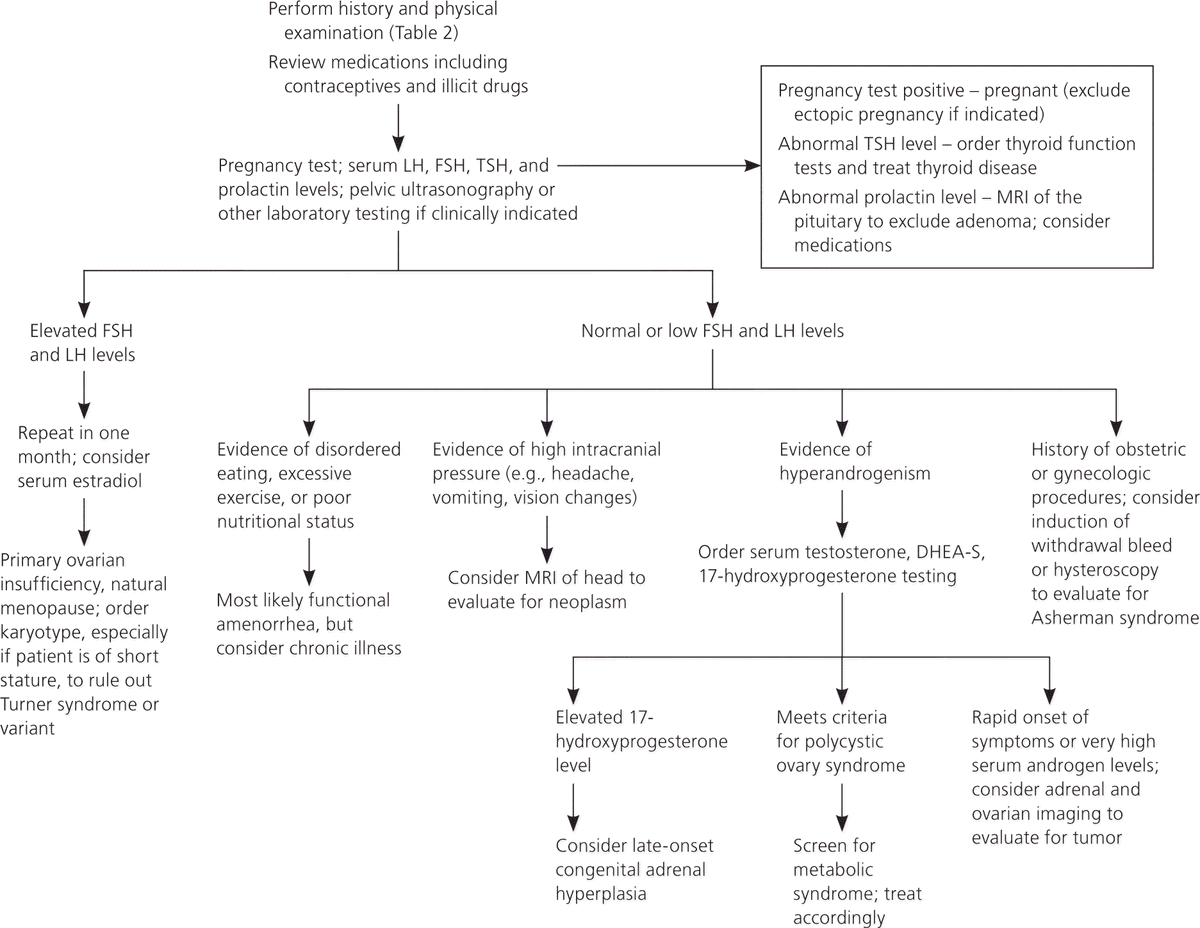 ” PloS one vol. 9,10 e108223. 13 Oct. 2014, doi:10.1371/journal.pone.0108223
” PloS one vol. 9,10 e108223. 13 Oct. 2014, doi:10.1371/journal.pone.0108223
[5] Labcorp Homocysteine.
[6] Smith, A David, and Helga Refsum. “Homocysteine, B Vitamins, and Cognitive Impairment.” Annual review of nutrition vol. 36 (2016): 211-39. doi:10.1146/annurev-nutr-071715-050947
[7] Willinek, W A et al. “High-normal serum homocysteine concentrations are associated with an increased risk of early atherosclerotic carotid artery wall lesions in healthy subjects.” Journal of hypertension vol. 18,4 (2000): 425-30. doi:10.1097/00004872-200018040-00011
[8] Zhang, Yanqiu et al. “Features and risk factors of carotid atherosclerosis in a population with high stroke incidence in China.” Oncotarget vol. 8,34 57477-57488. 16 Feb. 2017, doi:10.18632/oncotarget.15415
[9] Al-Bayyari, N et al. “Vitamin D3 reduces risk of cardiovascular and liver diseases by lowering homocysteine levels: double-blinded, randomised, placebo-controlled trial.” The British journal of nutrition vol.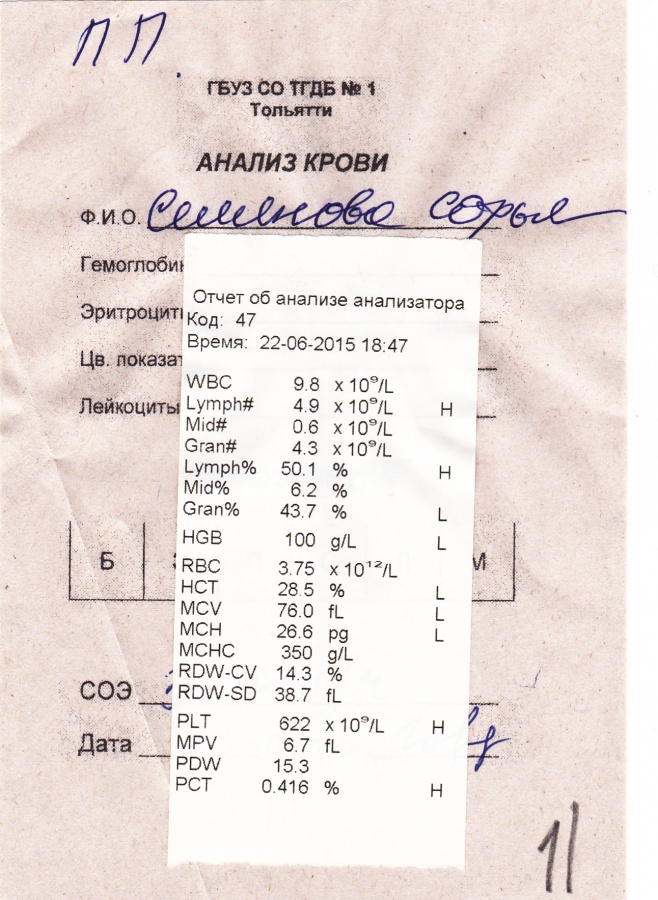 125,2 (2021): 139-146. doi:10.1017/S0007114520001890
125,2 (2021): 139-146. doi:10.1017/S0007114520001890
[10] Shih, C., Y. Shih, and J. Chen. “The Association Between Homocysteine Levels and Cardiovascular Disease Risk Among Middle-Aged and Elderly Adults in Taiwan.” (2020).
[11] Chen, Tien-Yu et al. “Short Sleep Duration Is Associated With Increased Serum Homocysteine: Insights From a National Survey.” Journal of clinical sleep medicine : JCSM : official publication of the American Academy of Sleep Medicine vol. 15,1 139-148. 15 Jan. 2019, doi:10.5664/jcsm.7588 [R}
[12] Pusceddu, Irene et al. “Subclinical inflammation, telomere shortening, homocysteine, vitamin B6, and mortality: the Ludwigshafen Risk and Cardiovascular Health Study.” European journal of nutrition vol. 59,4 (2020): 1399-1411. doi:10.1007/s00394-019-01993-8
[13] Kim, Byung Jin et al. “Associations of plasma homocysteine levels with arterial stiffness in prehypertensive individuals.” Clinical and experimental hypertension (New York, N.Y. : 1993) vol. 33,6 (2011): 411-7. doi:10.3109/10641963.2010.549274
33,6 (2011): 411-7. doi:10.3109/10641963.2010.549274
[14] Lim, Unhee, and Patricia A Cassano. “Homocysteine and blood pressure in the Third National Health and Nutrition Examination Survey, 1988-1994.” American journal of epidemiology vol. 156,12 (2002): 1105-13. doi:10.1093/aje/kwf157
[15] Pizzorno, Joseph. “Homocysteine: Friend or Foe?.” Integrative medicine (Encinitas, Calif.) vol. 13,4 (2014): 8-14.
[16] Wang, Yixuan et al. “Homocysteine as a risk factor for hypertension: a 2-year follow-up study.” PloS one vol. 9,10 e108223. 13 Oct. 2014, doi:10.1371/journal.pone.0108223
[17] Pagana, Kathleen Deska; Pagana, Timothy J.; Pagana, Theresa N. Mosby’s Diagnostic and Laboratory Test Reference – E-Book. Elsevier Health Sciences. 2019..
The Treatment of Hyperhomocysteinemia – PMC
1. Boushey CJ, Beresford SA, Omenn GS, Motulsky AG. A quantitative assessment of plasma homocysteine as a risk factor for vascular disease. Probable benefits of increasing folic acid intakes. J. Am. Med. Assoc. 1995;74:1049–57. [PubMed] [Google Scholar]
J. Am. Med. Assoc. 1995;74:1049–57. [PubMed] [Google Scholar]
2. Homocysteine Studies Collaboration Homocysteine and risk of ischemic heart disease and stroke; a meta-analysis. J. Am. Med. Assoc. 2002;288:2015–22. [PubMed] [Google Scholar]
3. Handy DE, Zhang Y, Loscalzo J. Homocysteine down-regulates cellular glutathione peroxidase (GPx1) by decreasing translation. J. Biol. Chem. 2005;280:15518–25. [PubMed] [Google Scholar]
4. Zhou J, Werstuck GH, Lhoták S, de Koning AB, Sood SK, et al. Association of multiple cellular stress pathways with accelerated atherosclerosis in hyperhomocysteinemic apolipoprotein E-deficient mice. Circulation. 2004;110:207–13. [PubMed] [Google Scholar]
5. Eberhardt RT, Forgione MA, Cap A, Leopold JA, Rudd MA, et al. Endothelial dysfunction in a murine model of mild hyperhomocyst(e)inemia. J. Clin. Invest. 2000;106:483–491. [PMC free article] [PubMed] [Google Scholar]
6. Loscalzo J. Homocysteine and dementias. N. Engl. J. Med. 2002;346:466–8.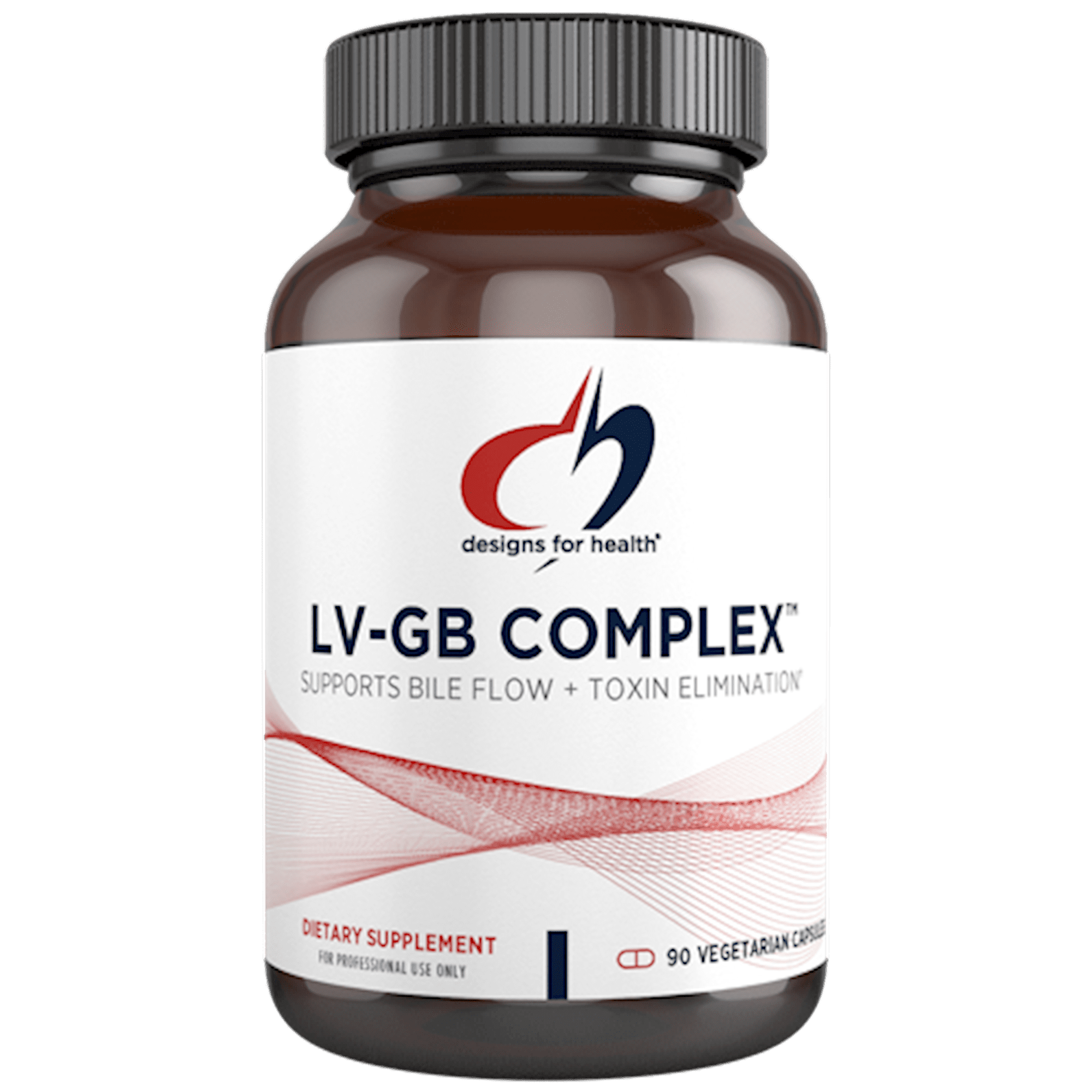 [PubMed] [Google Scholar]
[PubMed] [Google Scholar]
7. Seshardi S, Beiser A, Selhub J, Jacques PF, Rosenberg IH, et al. Plasma homocysteine as a risk factor for dementia and Alzheimer’s disease. N. Engl. J. Med. 2002;346:476–83. [PubMed] [Google Scholar]
8. McCully KS. Homocysteine, vitamins, and vascular disease prevention. Am. J. Clin. Nutr. 2007;86:1563S–8S. [PubMed] [Google Scholar]
9. Brazionis L, Rowley K, Sr, Itsiopoulos C, Harper CA, O’Dea K. Homocysteine and diabetic retinopathy. Diab. Care. 2008;31:50–6. [PubMed] [Google Scholar]
10. Agulló-Ortuño MT, Albaladejo MD, Parra S, Rodríguez-Manotas M, Fenollar M, et al. Plasmatic homocysteine concentration and its relationship with complications associated to diabetes mellitus. Clin. Chim. Acta. 2002;326:105–12. [PubMed] [Google Scholar]
11. Herrmann W, Herrmann M, Joseph J, Tyagi SC. The role of hyperhomocysteinemia as well as folate, vitamin B(6) and B(12) deficiencies in osteoporosis: a systematic review. Clin. Chem. Lab. Med.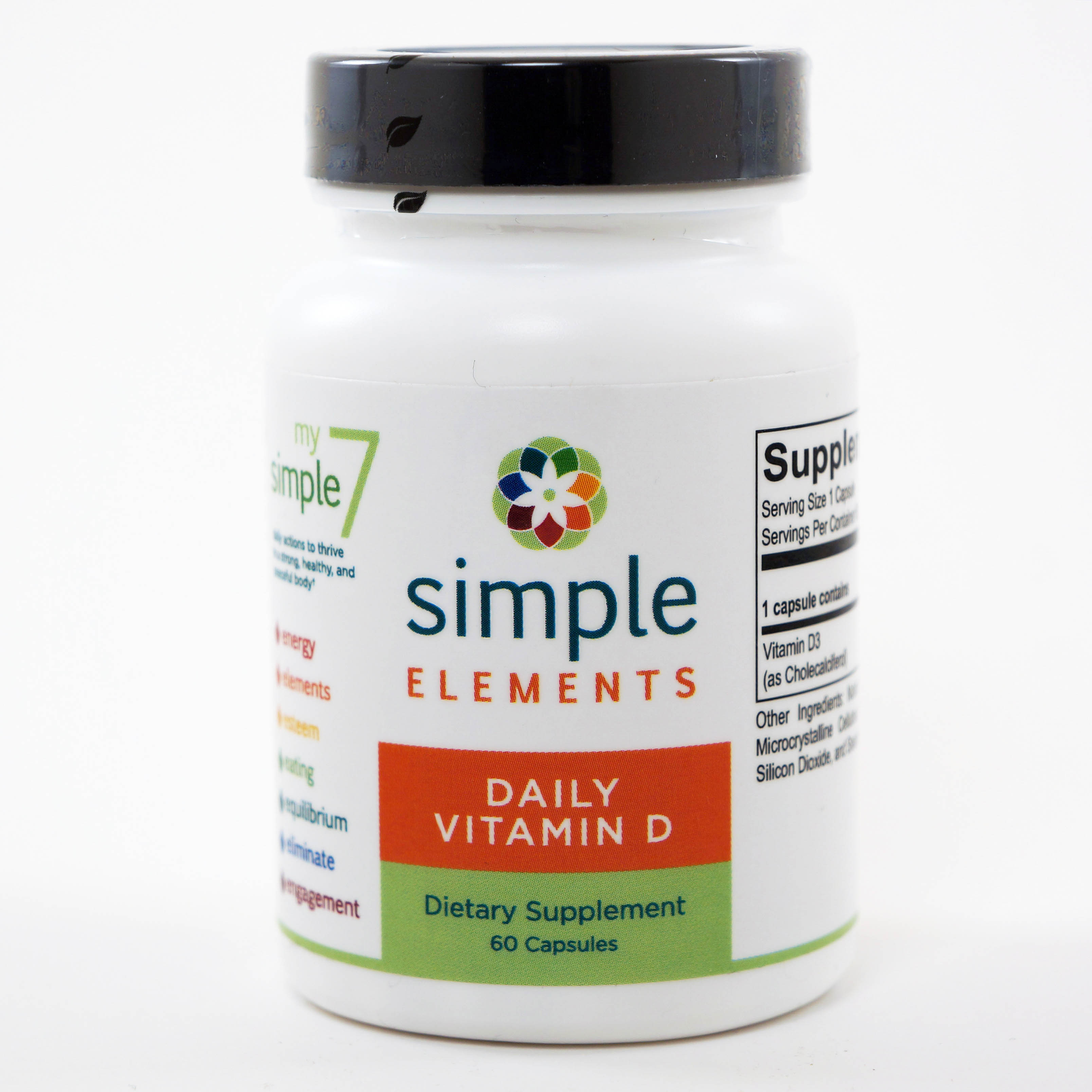 2007;45:1621–32. [PubMed] [Google Scholar]
2007;45:1621–32. [PubMed] [Google Scholar]
12. Jacques PF, Selhub J, Bostom AG, Wilson PW, Rosenberg IH. The effect of folic acid fortification on plasma folate and total homocysteine concentrations. N. Engl. J. Med. 1999;340:1449–54. [PubMed] [Google Scholar]
13. MRC Vitamin Study Research Group Prevention of neural tube defects: results of the Medical Research Council Vitamin Study. Lancet. 1991;338:131–7. [PubMed] [Google Scholar]
14. Refsum H, Ueland PM, Nygård O, Vollset SE. Homocysteine and cardiovascular disease. Annu. Rev. Med. 1998;49:31–62. [PubMed] [Google Scholar]
15. Graham IM, Daly LE, Refsum HM, Robinson K, Brattström LE, et al. Plasma homocysteine as a risk factor for vascular disease. The European Concerted Action Project. J. Am. Med. Assoc. 1997;277:1775–81. [PubMed] [Google Scholar]
16. Nygård O, Nordrehaug JE, Refsum H, Ueland PM, Farstad M, et al. Plasma homocysteine levels and mortality in patients with coronary artery disease. N. Eng. J. Med. 1997;337:23–36. [PubMed] [Google Scholar]
J. Med. 1997;337:23–36. [PubMed] [Google Scholar]
17. Wang TJ, Gona P, Larson MG, Tofler GH, Levy D, et al. Multiple biomarkers for the prediction of first major cardiovascular events and death. N. Engl. J. Med. 2006;355:2631–9. [PubMed] [Google Scholar]
18. Wald DS, Law M, Morris JK. Homocysteine and cardiovascular disease: evidence on causality from a meta-analysis. Br. Med. J. 2002;325:1202–9. [PMC free article] [PubMed] [Google Scholar]
19. Toole JF, Malinow MR, Chambless LE, Spence JD, Pettigrew LC, et al. Lowering Homocysteine in Patients With Ischemic Stroke to Prevent Recurrent Stroke, Myocardial Infarction, and Death: The Vitamin Intervention for Stroke Prevention (VISP) Randomized Controlled Trial. J. Am. Med. Assoc. 2004;291:565–75. [PubMed] [Google Scholar]
20. McMahon JA, Green TJ, Skeaff CM, Knight RG, Mann JI, et al. A controlled trial of homocysteine lowering and cognitive performance. N. Engl. J. Med. 2006;354:2764–72. [PubMed] [Google Scholar]
21. Sato Y, Honda Y, Iwamoto J, Kanoko T, Satoh K. Effect of folate and mecobalamin on hip fractures in patients with stroke: a randomized controlled trial. J. Am. Med. Assoc. 2005;293:1082–8. [PubMed] [Google Scholar]
Sato Y, Honda Y, Iwamoto J, Kanoko T, Satoh K. Effect of folate and mecobalamin on hip fractures in patients with stroke: a randomized controlled trial. J. Am. Med. Assoc. 2005;293:1082–8. [PubMed] [Google Scholar]
22. Maron BA, Loscalzo J. Should hyperhomocysteinemia be treated in patients with atherosclerotic disease? Curr. Atheroscler. Rep. 2007;9:375–83. [PubMed] [Google Scholar]
23. Weiss N, Keller C, Hoffmann U, Loscalzo J. Endothelial dysfunction and atherothrombosis in mild hyperhomocysteinemia. Vasc. Med. 2003;7:227–239. [PubMed] [Google Scholar]
24. Loscalzo J. The oxidant stress of hyperhomocyst(e)inemia. J. Clin. Invest. 1996;98:5–7. [PMC free article] [PubMed] [Google Scholar]
25. Lubos E, Loscalzo J, Handy DE. Homocysteine and glutathione peroxidase-1. Antioxid Redox Signal. 2007;9:1923–40. [PubMed] [Google Scholar]
26. Rounds S, Yee WL, Dawicki DD, Harrington E, Parks N. Mechanism of extracellular ATP- and adenosine-induced apoptosis of cultured pulmonary artery endothelial cells. Am. J. Physiol. 1998;275:L379–388. [PubMed] [Google Scholar]
Am. J. Physiol. 1998;275:L379–388. [PubMed] [Google Scholar]
27. Welch GN, Upchurch GR, Jr, Farivar RS, Pigazzi A, Vu K, et al. Homocysteine-induced nitric oxide production in vascular-smooth muscle cells by NF-kB-dependent transcriptional activation of Nos2. Proc. Assoc. Am. Physiol. 1998;110:22–31. [PubMed] [Google Scholar]
28. Finkelstein JD. Methionine metabolism in mammals. J. Nutr. Biochem. 1990;1:228–237. [PubMed] [Google Scholar]
29. Qi Z, Hoffman G, Kurtycz D, Yu J. Prevalence of the C677T substitution of the methylenetetrahydrofolate reductase (MTHFR) gene in Wisconsin. Genet. Med. 2003;5:458–9. [PubMed] [Google Scholar]
30. Malinow R, Bostom AG, Krauss RM. Homocyst(e)ine, Diet, and Cardiovascular Diseases:A Statement for Healthcare Professionals From the Nutrition Committee, American Heart Association. Circulation. 1999;99:178–82. [PubMed] [Google Scholar]
31. Kolling K, Ndrepepa G, Koch W, Braun S, Mehilli J, et al. Methylenetetrahydrofolate reductase gene C677T and A1298C polymorphisms, plasma homocysteine, folate, and vitamin B12 levels and the extent of coronary artery disease. Am. J. Cardiol. 2004;93:1201–06. [PubMed] [Google Scholar]
Am. J. Cardiol. 2004;93:1201–06. [PubMed] [Google Scholar]
32. Garovic-Kocic V, Rosenblatt DS. Methionine auxotrophy in inborn errors of cobalamin metabolism. Clin. Invest. Med. 1995;15:395–400. [PubMed] [Google Scholar]
33. Welch GN, Loscalzo J. Homocysteine and atherothrombosis. N. Engl. J. Med. 1998;338:1042–50. [PubMed] [Google Scholar]
34. Mudd SH, Levy HL, Skovby F. Disorders of transsulfuration. In: Scriver CR, Beaudet AL, Sly WS, Valle DL, editors. The metabolic and molecular bases of inherited disease. 1. Vol. 7. McGraw-Hill; New York: 1995. pp. 1279–327. [Google Scholar]
35. Mandel H, Brenner B, Berant M, Rosenberg N, Lanir N, et al. Coexistence of hereditary homocystinuria and factor V Leiden–effect on thrombosis. N. Engl. J. Med. 1996;334:763–8. [PubMed] [Google Scholar]
36. McCully KS. Vascular pathology of homocysteine-emia: implications for the pathogenesis of arteriosclerosis. Am. J. Pathol. 1969;56:111–28. [PMC free article] [PubMed] [Google Scholar]
37. Hiltunen MO, Yia-herttuala S. DNA methylation, smooth muscle cells, and atherogenesis. Arterioscler. Thromb. Vasc. Biol. 2003;23:1750–53. [PubMed] [Google Scholar]
Hiltunen MO, Yia-herttuala S. DNA methylation, smooth muscle cells, and atherogenesis. Arterioscler. Thromb. Vasc. Biol. 2003;23:1750–53. [PubMed] [Google Scholar]
38. Babior BM, Bunn FH. Meagaloblastic anemias. In: Kasper D, Braunwald E, Fauci A, Hauser S, Longo D, Jameson L, editors. Harrison’s Principles of Internal Medicine. 16th edition McGraw-Hill; New York: 2005. pp. 601–7. [Google Scholar]
39. Kim YI. Folic acid fortification and supplementation–good for some but not so good for others. Nutr. Rev. 2007;65:504–11. [PubMed] [Google Scholar]
40. Andrès E, Affenberger S, Vinzio S, Kurtz JE, Noel E, et al. Food-cobalamin malabsorption in elderly patients: clinical manifestations and treatment. Am. J. Med. 2005;118:1154–9. [PubMed] [Google Scholar]
41. Lindenbaum J, Rosenberg IH, Wilson PWF, Stabler S, Allen RH. Prevalence of cobalamin deficiency in the Framingham elderly population. Am. J. Clin. Nutr. 1994;60:2–11. [PubMed] [Google Scholar]
42. Shane B, Stokstad EL. Vitamin B12-folate interrelationships. Annu. Rev. Nutr. 1985;5:115–41. [PubMed] [Google Scholar]
Shane B, Stokstad EL. Vitamin B12-folate interrelationships. Annu. Rev. Nutr. 1985;5:115–41. [PubMed] [Google Scholar]
43. Cravo ML, Glória LM, Selhub J, Nadeau MR, Camilo ME, et al. Hyperhomocysteinemia in chronic alcoholism: correlation with folate, vitamin B12, and vitamin B6 status. Am. J. Clin. Nutr. 1996;63:220–4. [PubMed] [Google Scholar]
44. Cravo ML, Camilo ME. Hyperhomocysteinemia in chronic alcoholism: relations to folic acid and vitamins B(6) and B(12) status. Nutrition. 2000;16:296–302. [PubMed] [Google Scholar]
45. Hron G, Lombardi R, Eichinger S, Lecchi A, Kyrle PA, et al. Low vitamin B6 levels and the risk of recurrent venous thromboembolism. Haematologica. 2007;92:1250–3. [PubMed] [Google Scholar]
46. Ray M, Kumar L, Prasad R. Homocystinuria with early thromboembolic episodes and rapid response to high dose pyridoxine. Indian. Pediatr. 1997;34:67–9. [PubMed] [Google Scholar]
47. Jamison RJ, Hartigan P, Kaufman JS, Goldfarb DS, Warren SR, et al. For the Veterans Affairs Site Investigators Effect of Homocysteine Lowering on Mortality and Vascular Disease in Advanced Chronic Kidney Disease and End-stage Renal Disease: A Randomized Controlled Trial. J. Am. Med. Assoc. 2007;298:1163–70. [PubMed] [Google Scholar]
For the Veterans Affairs Site Investigators Effect of Homocysteine Lowering on Mortality and Vascular Disease in Advanced Chronic Kidney Disease and End-stage Renal Disease: A Randomized Controlled Trial. J. Am. Med. Assoc. 2007;298:1163–70. [PubMed] [Google Scholar]
48. Robinson K, Gupta A, Dennis V, Arheart K, Chaudhary D, et al. Hyperhomocysteinemia confers an independent increased risk of atherosclerosis in end-stage renal disease and is closely linked to plasma folate and pyridoxine concentrations. Circulation. 1996;94:2743–8. [PubMed] [Google Scholar]
49. Shemin D, Lapane KL, Bausserman L, Kanaan E, Kahn S, et al. Plasma total homocysteine and hemodialysis access thrombosis: a prospective study. J. Am. Soc. Nephrol. 1999;10:1095–9. [PubMed] [Google Scholar]
50. Go AS, Chertow GM, Fan D, McCulloch CE, Hsu CY. Chronic kidney disease and the risks of death, cardiovascular events, and hospitalization. N. Engl. J. Med. 2004;351:1296–305. [PubMed] [Google Scholar]
51.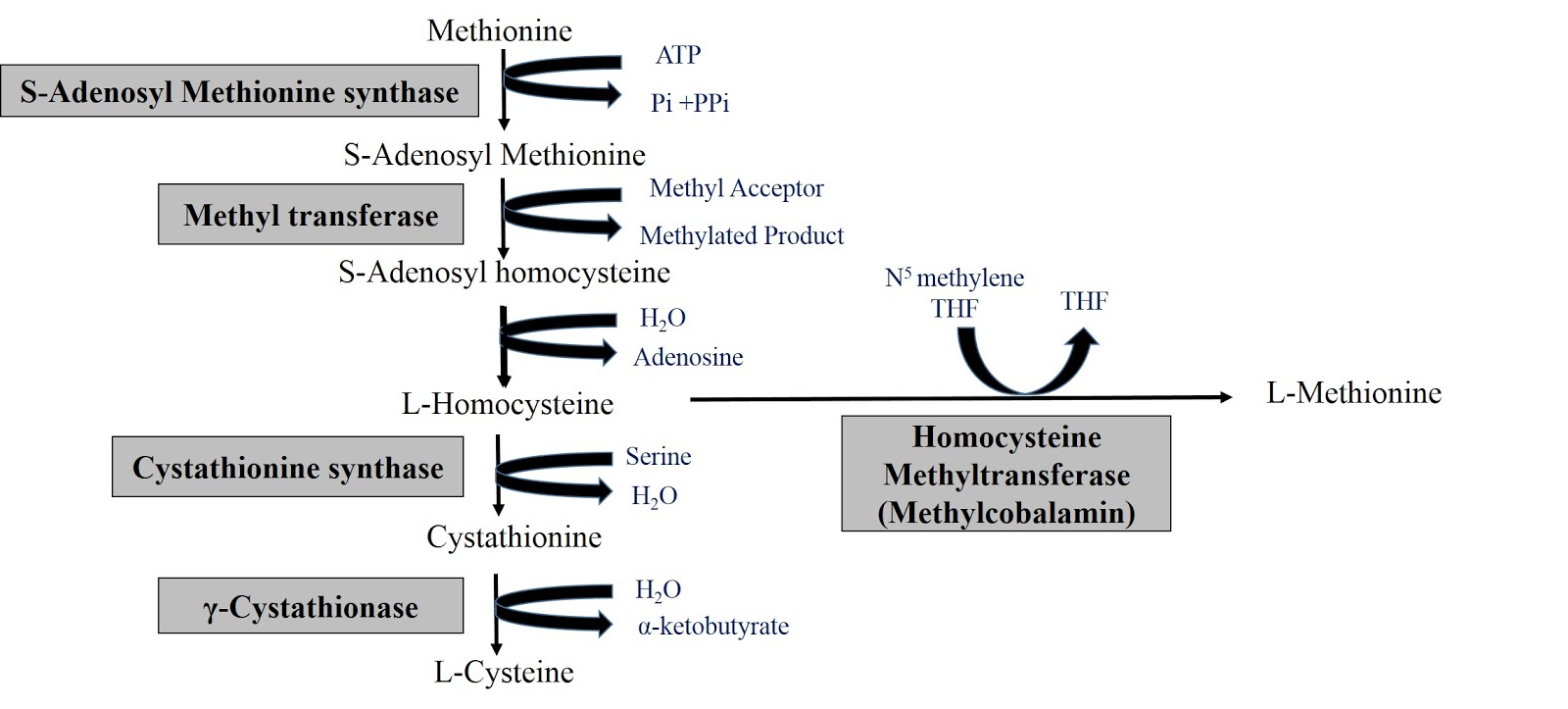 Garibotto G, Sofia A, Valli A, Tarroni A, Di Martino M, et al. Causes of hyperhomocysteinemia in patients with chronic kidney diseases. Semin. Nephrol. 2006;26:3–7. [PubMed] [Google Scholar]
Garibotto G, Sofia A, Valli A, Tarroni A, Di Martino M, et al. Causes of hyperhomocysteinemia in patients with chronic kidney diseases. Semin. Nephrol. 2006;26:3–7. [PubMed] [Google Scholar]
52. Zoungas S, McGrath BP, Branley P, Kerr PG, Muske C, et al. Cardiovascular morbidity and mortality in the Atherosclerosis and Folic Acid Supplementation Trial (ASFAST) in chronic renal failure: a multicenter, randomized, controlled trial. J. Am. Coll. Cardiol. 2006;47:1108–16. [PubMed] [Google Scholar]
53. Wrone EM, Hornberger JM, Zehnder JL, McCann LM, Coplon NS, et al. Randomized trial of folic acid for prevention of cardiovascular events in end-stage renal disease. J. Am. Soc. Nephrol. 2004;15:420–6. [PubMed] [Google Scholar]
54. Steegers-Theunissen RP, Boers GH, Steegers EA, Trijbels FJ, Thomas CM, et al. Effects of sub-50 oral contraceptives on homocysteine metabolism: a preliminary study. Contraception. 1992;45:129–139. [PubMed] [Google Scholar]
55. Lonne E, Yusuf S, Arnold MJ, Sheridan P, Pogue J, et al. Homocysteine lowering with folic acid and B vitamins in vascular disease. N. Eng.l J. Med. 2006;354:1567–77. [PubMed] [Google Scholar]
Homocysteine lowering with folic acid and B vitamins in vascular disease. N. Eng.l J. Med. 2006;354:1567–77. [PubMed] [Google Scholar]
56. Bønna KH, Njolstad I, Ueland PM, Schirmer H, Tverdal A, et al. Homocysteine lowering and cardiovascular events after acute myocardial infarction. N. Engl. J. Med. 2006;354:1578–88. [PubMed] [Google Scholar]
57. Bazzano LA, Renolds K, Holder KN, He J. Effect of folic acid supplementation on risk of cardiovascular diseases: a meta-analysis of randomized controlled trials. J. Am. Med. Assoc. 2006;296:2720–6. [PubMed] [Google Scholar]
58. Schnyder G, et al. Effect of Homocysteine-Lowering Therapy With Folic Acid, Vitamin B12, and Vitamin B6 on Clinical Outcome After Percutaneous Coronary Intervention: The Swiss Heart Study: A Randomized Controlled Trial. J. Am. Med. Assoc. 2002;288:973–9. [PubMed] [Google Scholar]
59. Lange H, Surapranata H, De Luca G, Börner C, Dille J. Folate therapy and in-stent restenosis after coronary stenting.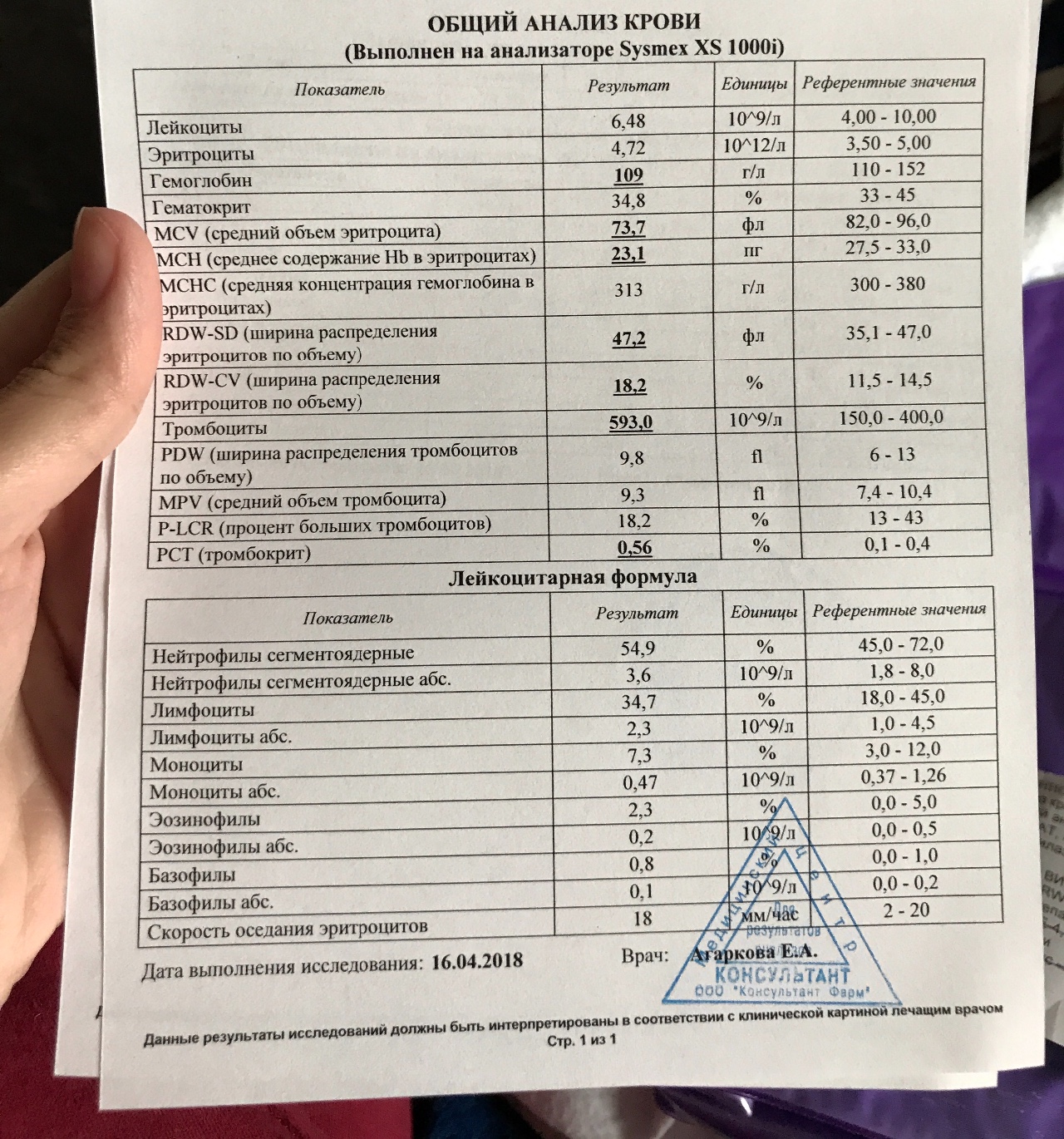 N. Engl. J. Med. 2004;350:2673–81. [PubMed] [Google Scholar]
N. Engl. J. Med. 2004;350:2673–81. [PubMed] [Google Scholar]
60. Wang X, Qin X, Demirtas H, Li J, Mao G, et al. Efficacy of folic acid supplementation in stroke prevention: a meta-analysis. Lancet. 2007;369:1876–82. [PubMed] [Google Scholar]
61. Böger RH, Sydow K, Borlak J, Thum T, Lenzen H, et al. LDL cholesterol upregulates synthesis of asymmetrical dimethylarginine in human endothelial cells: involvement of S-adenosylmethionine-dependent methyltransferases. Circ. Res. 2000;87:99–105. [PubMed] [Google Scholar]
62. Jakubowski H, Zhang L, Bardeguez A, Aviv A. Homocysteine thiolactone and protein homocysteinylation in human endothelial cells: implications for atherosclerosis. Circ. Res. 2000;87:45–51. [PubMed] [Google Scholar]
63. Cummings JL. Alzheimer’s disease. N. Engl. J. Med. 2004;351:56–67. [PubMed] [Google Scholar]
64. Hofman A, Ott A, Breteler MM, Bots ML, Slooter AJ, et al. Atherosclerosis, apolipoprotein E, and prevalence of dementia and Alzheimer’s disease in the Rotterdam Study. Lancet. 1997;349:151–4. [PubMed] [Google Scholar]
Lancet. 1997;349:151–4. [PubMed] [Google Scholar]
65. Snowdon DA, Greiner LH, Mortimer JA, Riley KP, Greiner PA, et al. Brain infarction and the clinical expression of Alzheimer disease. The Nun Study. J. Am. Med. Assoc. 1997;277:813–7. [PubMed] [Google Scholar]
66. Ravaglia G, Forti P, Maioli F, Martelli M, Servadei L, et al. Homocysteine and folate as risk factors for dementia and Alzheimer disease. Am. J. Clin. Nutr. 2005;82:636–43. [PubMed] [Google Scholar]
67. Kim J, Park MH, Kim E, Han C, Jo SA, et al. Plasma homocysteine is associated with the risk of mild cognitive impairment in an elderly Korean population. J. Nutr. 2007;137:2093–7. [PubMed] [Google Scholar]
68. Reynolds E. Vitamin B12, folic acid, and the nervous system. Lancet Neurol. 2006;5:949–60. [PubMed] [Google Scholar]
69. Shastry S, Moning L, Tyagi N, Steed M, Tyagi SC. GABA receptors and nitric oxide ameliorate constrictive collagen remodeling in hyperhomocysteinemia. J. Cell Physiol.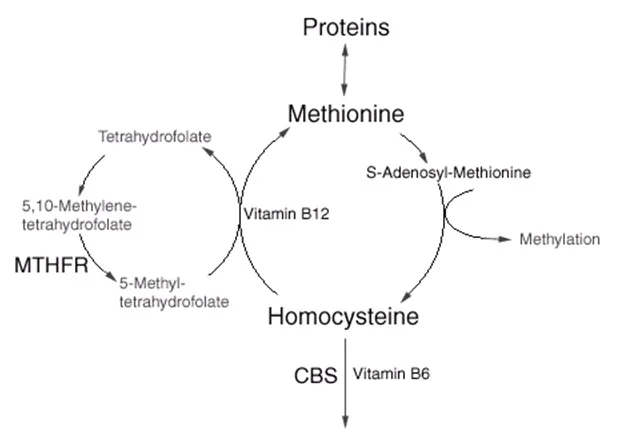 2005;205:422–7. [PubMed] [Google Scholar]
2005;205:422–7. [PubMed] [Google Scholar]
70. Loscalzo J. Homocysteine and dementias. N. Engl. J. Med. 2002;346:466–8. [PubMed] [Google Scholar]
71. Lipton SA, Kim WK, Choi YB, Kumar S, D’Emilia DM, et al. Neurotoxicity associated with dual actions of homocysteine at the N-methyl-D-aspartate receptor. Proc. Natl. Acad. Sci. U.S.A. 1997;94:5923–8. [PMC free article] [PubMed] [Google Scholar]
72. Eussen SJ, de Groot LC, Joosten LW, Bloo RJ, Clarke R, et al. Effect of oral vitamin B-12 with or without folic acid on cognitive function in older people with mild vitamin B-12 deficiency: a randomized, placebo-controlled trial. Am. J. Clin. Nutr. 2006;84:361–70. [PubMed] [Google Scholar]
73. Lewerin C, Matousek M, Steen G, Johansson B, Steen B, et al. Significant correlations of plasma homocysteine and serum methylmalonic acid with movement and cognitive performance in elderly subjects but no improvement from short-term vitamin therapy: a placebo-controlled randomized study. Am. J. Clin. Nutr. 2005;81:1155–62. [PubMed] [Google Scholar]
Am. J. Clin. Nutr. 2005;81:1155–62. [PubMed] [Google Scholar]
74. Sun Y, Lu CJ, Chien KL, Chen ST, Chen RC. Efficacy of multivitamin supplementation containing vitamins B6 and B12 and folic acid as adjunctive treatment with a cholinesterase inhibitor in Alzheimer’s disease: a 26-week, randomized, double-blind, placebo-controlled study in Taiwanese patients. Clin. Ther. 2007;29:2204–14. [PubMed] [Google Scholar]
75. Durga J, van Boxtel MP, Schouten EG, Kok FJ, Jolles J, et al. Effect of 3-year folic acid supplementation on cognitive function in older adults in the FACIT trial: a randomized, double blind, controlled trial. Lancet. 2007;369:208–16. [PubMed] [Google Scholar]
76. Vitvitsky V, Thomas M, Ghorpade A, Gendelman HE, Banerjee R. A functional transsulfuration pathway in the brain links to glutathione homeostasis. J. Biol. Chem. 2006;281:35785–93. [PubMed] [Google Scholar]
77. van Meurs JB, Trikalinos TA, Ralston SH, Balcells S, Brandi ML, et al. Large-scale analysis of association between LRP5 and LRP6 variants and osteoporosis. J. Am. Med. Assoc. 2008;299:1277–90. [PMC free article] [PubMed] [Google Scholar]
Large-scale analysis of association between LRP5 and LRP6 variants and osteoporosis. J. Am. Med. Assoc. 2008;299:1277–90. [PMC free article] [PubMed] [Google Scholar]
78. Massé PG, Boskey AL, Ziv I, Hauschka P, Donovan SM, et al. Chemical and biomechanical characterization of hyperhomocysteinemic bone disease in an animal model. BMC Musculoskelet. Disord. 2003;4:2. [PMC free article] [PubMed] [Google Scholar]
79. Pyeritz RE. Homocystineuria. In: Beighton P, editor. McKusick’s Heritable Disorders of Connective Tissue. Vol. 193. Mosby; St Louis: 2005. pp. 137–78. [Google Scholar]
80. van Meurs JB, Dhonukshe-Rutten RA, Pluijm SM, van der Klift M, de Jonge R, et al. Homocysteine levels and the risk of osteoporotic fracture. N. Engl. J. Med. 2004;350:2033–41. [PubMed] [Google Scholar]
81. McLean RR, Jacques PF, Selhub J, Tucker KL, Samelson EJ, et al. Homocysteine as a predictive factor for hip fracture in older persons. N. Engl. J. Med. 2004;350:2042–9. [PubMed] [Google Scholar]
82. Sawka AM, Ray JG, Yi Q, Josse RG, Lonn E. Randomized clinical trial of homocysteine level lowering therapy and fractures. Arch. Intern. Med. 2007;167:2136–9. [PubMed] [Google Scholar]
Sawka AM, Ray JG, Yi Q, Josse RG, Lonn E. Randomized clinical trial of homocysteine level lowering therapy and fractures. Arch. Intern. Med. 2007;167:2136–9. [PubMed] [Google Scholar]
83. Green TJ, McMahon JA, Skeaff CM, Williams SM, Whiting SJ. Lowering homocysteine with B vitamins has no effect on biomarkers of bone turnover in older persons: a 2-y randomized controlled trial. Am. J. Clin. Nutr. 2007;85:460–4. [PubMed] [Google Scholar]
84. Hoffbrand AV. Meagaloblastic anemias. In: Fauci A, Braunwald E, Kasper D, Hauser S, Longo D, Jameson L, Loscalzo J, editors. Harrison’s Principles of Internal Medicine. 17th Edition. McGraw-Hill; New York: 2008. pp. 643–51. Megaloblastic Anemias. [Google Scholar]
85. Palm F, Onozato ML, Luo Z, Wilcox CS. Dimethylarginine dimethylaminohydrolase (DDAH): expression, regulation, and function in the cardiovascular and renal systems. Am. J. Physiol. Heart Circ. Physiol. 2007;293:h4227–45. [PubMed] [Google Scholar]
✚ Homocysteine as a risk factor for the development of neuropsychiatric disorders.
 Professor Minutko’s neuropsychiatric clinic. Article No. 7000
Professor Minutko’s neuropsychiatric clinic. Article No. 7000
Numerous publications have appeared in the psychoneurological literature on the role of homocysteine (Hcy), a sulfur-containing amino acid that is not a dietary component and does not form proteins.
Homocysteine is obtained exclusively due to the demethylation of methionine, an amino acid that is part of plant and animal proteins and is the main source of protein sulfur atoms.
The demethylation process is an important metabolic pathway leading to important methylation reactions in the body. Homocysteine is either remethylated to methionine (a process that uses folate and vitamin B12 as cofactors) or catabolized by transsulfuration to cystathionine if excess Hcy is present (using vitamin B6 as a cofactor).
Enzymes of homocysteine metabolism
Three major enzymes are involved in homocysteine metabolism: methionine synthase (MS) and 5-methyltetrahydrofolate reductase (MHTFR) in remethylation and cystathion-b-synthase (CBS) in transsulfuration. These enzymes, along with coenzymes, maintain intracellular homocysteine concentrations within a narrow range, even though plasma levels vary widely.
These enzymes, along with coenzymes, maintain intracellular homocysteine concentrations within a narrow range, even though plasma levels vary widely.
Plasma homocysteine is approximately 70% bound to albumin and exists in many forms: reduced, oxidized and mixed disulfides containing homocysteine and other thiols.
Laboratory tests
Most laboratories measure the total pool of homocysteine (tHcy) in plasma, usually from a fasting sample. A homocysteine test can be performed by measuring tHcy 2-8 hours after an oral methionine load (100 mg methionine per kg of body weight).
Normal plasma range for tHcy is between 5 and 15 µmol/L. Hyperhomocysteinemia is quite common, and elevated Hcy levels can be moderate (15-30 µmol/L), intermediate (31-100 µmol/L), or severe (>100 µmol/L).
Hyperhomocystenemia
Homocysteine is recognized as an independent risk factor for the development of atherosclerosis of the coronary, cerebral and peripheral arteries. High levels of homocysteine cause damage to endothelial cells due to impaired endothelial-dependent vasodilation, endogenous tissue-type plasminogen activator activity, and reduced endothelial DNA synthesis. High levels of Hcy also lead to a decrease in intracellular levels of adenosine, which has a cardio- and vasoprotective effect. Hcy induces the release of many inflammatory mediators that play an active role in the pathogenesis of atherosclerosis, such as TNFα, and its effects on the receptor for progressive glycation end products (RAGE) and its signaling ligand (EN-RAGE) are also worth noting. Thrombosis is enhanced by effects on platelet aggregation, increased synthesis of thromboxane A and reduced synthesis of prostacyclin, and the coagulation cascade is enhanced by activation of factors V, X and XII and inhibition of natural anticoagulants. Hcy promotes smooth muscle growth and lipoprotein(a) binding to fibrin.
High levels of homocysteine cause damage to endothelial cells due to impaired endothelial-dependent vasodilation, endogenous tissue-type plasminogen activator activity, and reduced endothelial DNA synthesis. High levels of Hcy also lead to a decrease in intracellular levels of adenosine, which has a cardio- and vasoprotective effect. Hcy induces the release of many inflammatory mediators that play an active role in the pathogenesis of atherosclerosis, such as TNFα, and its effects on the receptor for progressive glycation end products (RAGE) and its signaling ligand (EN-RAGE) are also worth noting. Thrombosis is enhanced by effects on platelet aggregation, increased synthesis of thromboxane A and reduced synthesis of prostacyclin, and the coagulation cascade is enhanced by activation of factors V, X and XII and inhibition of natural anticoagulants. Hcy promotes smooth muscle growth and lipoprotein(a) binding to fibrin.
Homocysteine can also exert direct neurotoxic effects through apoptosis induction and NMDA-mediated excitotoxicity, and its metabolite homocysteine is also excitotoxic.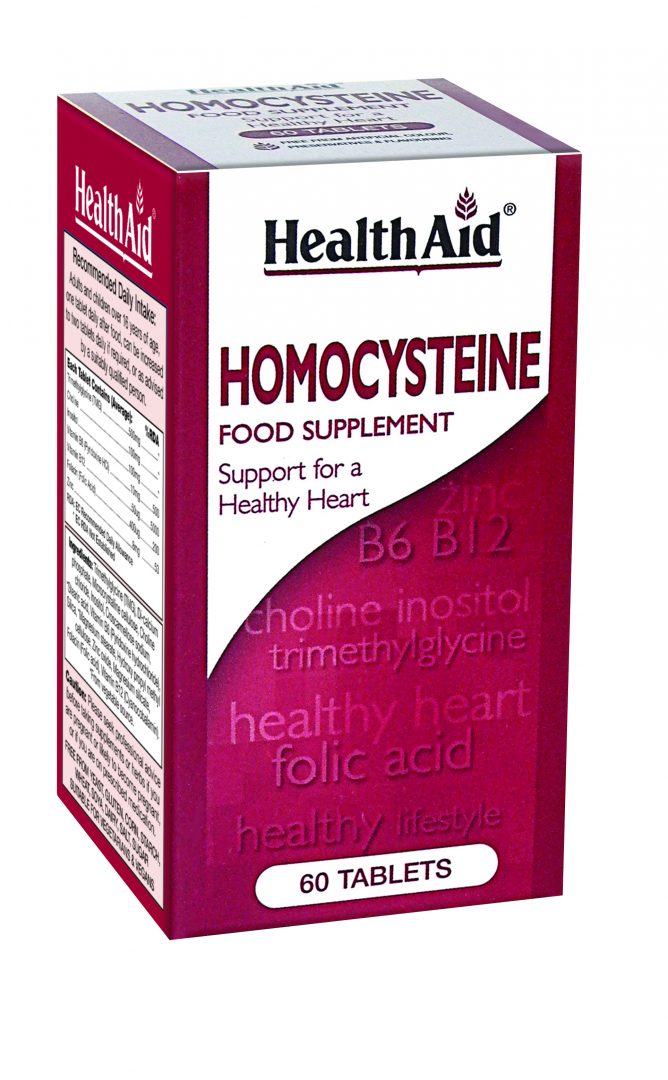 It has been experimentally shown that exposure of rat hippocampal neurons to homocysteine leads to activation of poly-ADP-ribose polymerization (PARP) and NAD depletion, which precede mitochondrial dysfunction, oxidative stress, caspase activation, and neuronal apoptosis.
It has been experimentally shown that exposure of rat hippocampal neurons to homocysteine leads to activation of poly-ADP-ribose polymerization (PARP) and NAD depletion, which precede mitochondrial dysfunction, oxidative stress, caspase activation, and neuronal apoptosis.
Causes of hyperhomocystenemia
Causes of elevated Hcy levels are numerous and may be genetic or acquired. The most common genetic abnormality in homocysteine metabolism is a substitution at nucleotide 677 (C677T) in the gene encoding the MTHFR enzyme, making it approximately 50% less active. In population studies in Western countries, 9-17% of the population were homozygous for this mutant enzyme and 30-41% were heterozygous. Homozygous deficiency of CBS is rare and causes homocystinuria, but its heterozygous deficiency resulting in a mild increase in Hcy is present in 1 in 300 people.
Acquired causes of hyperhomocysteinemia include cofactor deficiencies (vitamins B12, B6 and folate), age, medical conditions such as kidney failure and hypothyroidism, drugs that interfere with the metabolism of vitamins B12, B6 or folate, and lifestyle factors such as cigarette smoking .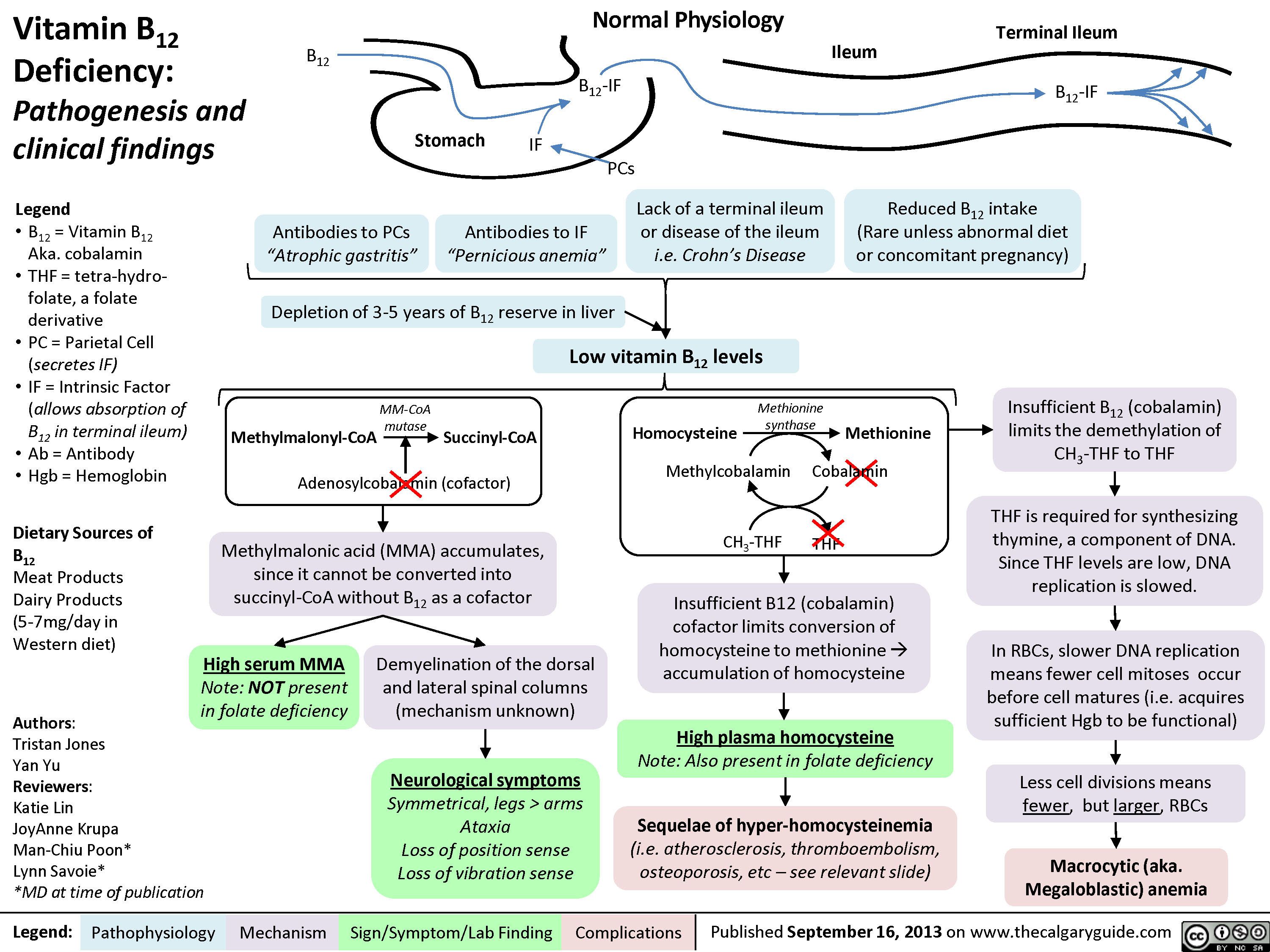 alcoholism, diet and sedentary lifestyle.
alcoholism, diet and sedentary lifestyle.
Homocysteine and neuropsychiatric disorders
High homocysteine levels are likely to lead to brain damage and neuropsychiatric disorders. In fact, homocysteine is proatherogenic and prothrombotic, which increases the risk of cerebrovascular disease and may have a direct neurotoxic effect. And indeed studies confirm an increase in the prevalence of stroke and vascular dementia in individuals with hyperhomocysteinemia. The relationship of homocysteine with depression, as with epilepsy, is still tentative.
We remind the reader that hyperhomocysteinemia should be treated with folic acid (folic acid at doses of 0.5 to 5 mg folate per day reduces homocysteine levels by 25%). A study comparing doses of 0.2, 0.4, 0.6, 0.8, and 1.0 mg per day of folic acid showed the greatest reduction in Hcy at the 0.8 mg dose, with betaine being less effective. A meta-analysis of the effects of vitamin B12 showed that a dose of 0. 02 to 1 mg/day caused an additional decrease in Hcy by about 7%. Note that folic acid treatment is associated with a risk of accelerated subacute combined degeneration of the spinal cord in individuals with subclinical vitamin B12 deficiency. This can be avoided either by ruling out vitamin B12 deficiency prior to initiating folate therapy, or by supplementing with folic acid with vitamin B12 at a dose of 400 mg/day or more. Long-term treatment with vitamin B6 at doses greater than 400 mg/day may cause sensory peripheral neuropathy. In the United States of America, there is a mandatory requirement that flours and cereals be fortified with 140 micrograms of folic acid per 100 grams of flour, and this has been estimated to be associated with a 3% reduction in the risk of homocysteine-related coronary artery stenosis.
02 to 1 mg/day caused an additional decrease in Hcy by about 7%. Note that folic acid treatment is associated with a risk of accelerated subacute combined degeneration of the spinal cord in individuals with subclinical vitamin B12 deficiency. This can be avoided either by ruling out vitamin B12 deficiency prior to initiating folate therapy, or by supplementing with folic acid with vitamin B12 at a dose of 400 mg/day or more. Long-term treatment with vitamin B6 at doses greater than 400 mg/day may cause sensory peripheral neuropathy. In the United States of America, there is a mandatory requirement that flours and cereals be fortified with 140 micrograms of folic acid per 100 grams of flour, and this has been estimated to be associated with a 3% reduction in the risk of homocysteine-related coronary artery stenosis.
Stroke
Homocysteine is considered an independent risk factor for cerebrovascular disease, with a pooled odds ratio of 1.9 per 5 µmol/L increase in plasma homocysteine. The researchers found a significant trend towards an increased risk of stroke with increasing tHcy, while a study of women found an increased risk of myocardial infarction and stroke only in patients who had a homocysteine level of at least 13.26 µmol/L. The Rotterdam study found a positive correlation between an increase in tHcy and the risk of stroke, especially lacunar strokes, with a 7% increase in risk of all strokes per 1 µmol/L with an increase in tHcy.
The researchers found a significant trend towards an increased risk of stroke with increasing tHcy, while a study of women found an increased risk of myocardial infarction and stroke only in patients who had a homocysteine level of at least 13.26 µmol/L. The Rotterdam study found a positive correlation between an increase in tHcy and the risk of stroke, especially lacunar strokes, with a 7% increase in risk of all strokes per 1 µmol/L with an increase in tHcy.
Vascular dementia
The association of homocysteine with stroke also makes it a risk factor for vascular dementia (VaD). The researchers also noted that they found Hcy to be a significant determinant of deep but not periventricular hyperintensity.
Alzheimer’s disease
That homocysteine may be associated with neurodegenerative disease is an interesting finding that has been confirmed by many authors. A number of the latter have demonstrated a correlation between homocysteine levels and the severity of cognitive impairment. It was noted that patients with baseline tHcy levels in the upper two tertiles had significantly higher temporal lobe atrophy at 3 years than those with the lowest tertiles, suggesting that elevated tHcy levels may also determine the rate of disease progression. A cross-sectional MRI study described a similar correlation between high homocysteine levels and cerebral atrophy in the elderly, suggesting the possibility that hyperhomocysteinemia is indeed neurotoxic.
It was noted that patients with baseline tHcy levels in the upper two tertiles had significantly higher temporal lobe atrophy at 3 years than those with the lowest tertiles, suggesting that elevated tHcy levels may also determine the rate of disease progression. A cross-sectional MRI study described a similar correlation between high homocysteine levels and cerebral atrophy in the elderly, suggesting the possibility that hyperhomocysteinemia is indeed neurotoxic.
Depression
The association between depression and B vitamins, particularly folic acid and vitamin B12, appears to be of much greater interest to researchers than the focus on homocystinemia. Two large correlational studies found an association between depression and folic acid and B12, not homocysteine levels. It is interesting to note that 50% of inpatients with depression have elevated homocysteine levels and only a few patients with low red blood cell folic acid, while subjects with high homocysteine levels have higher Hamilton Depression Rating Scale (HDRS) scores.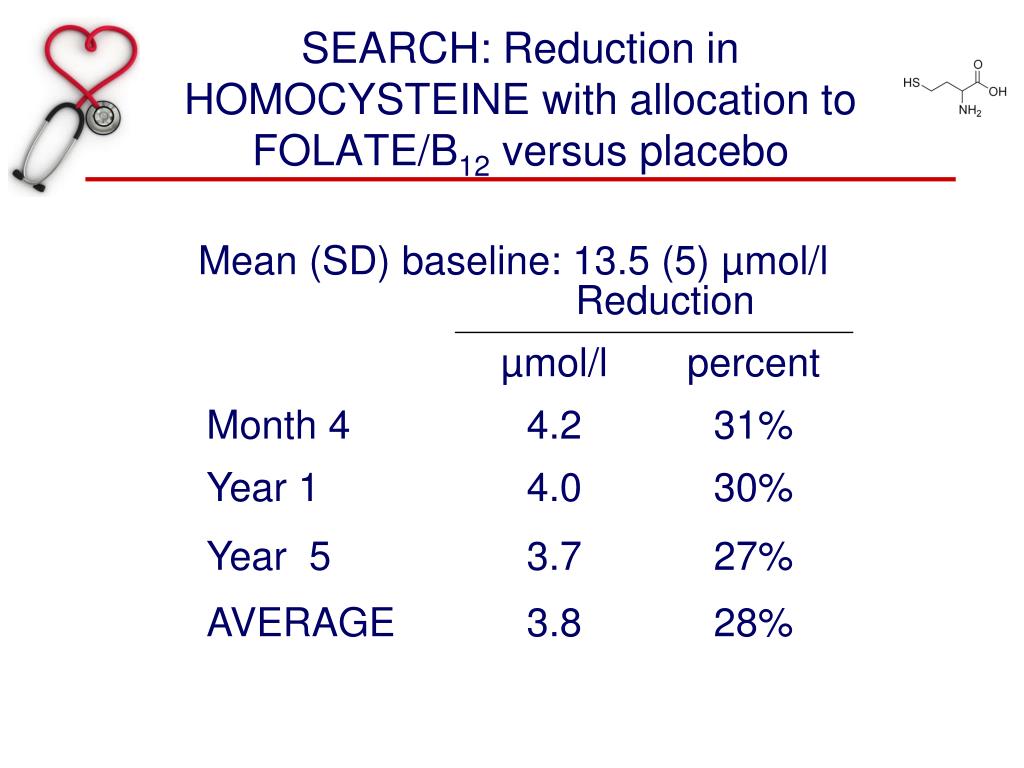 A study on late-onset depression found higher rates of the C677T MHTFR mutation in this group compared to early-onset depression. The relatively large number of depressed patients with subclinical B vitamin deficiencies suggests that these changes may be the result of depression-related anorexia rather than being involved in the pathogenesis of depression. Of note, folate deficiency is associated with poor response to antidepressants, suggesting that increasing folate may improve the effectiveness of depression therapy.
A study on late-onset depression found higher rates of the C677T MHTFR mutation in this group compared to early-onset depression. The relatively large number of depressed patients with subclinical B vitamin deficiencies suggests that these changes may be the result of depression-related anorexia rather than being involved in the pathogenesis of depression. Of note, folate deficiency is associated with poor response to antidepressants, suggesting that increasing folate may improve the effectiveness of depression therapy.
Decrease in plasma homocysteine levels in women taking folate and fluoxetine correlates with improvement, while vitamin B12 levels are not associated with clinical response. It is likely that women’s differential response to folic acid supplementation may be due to the fact that men require more folate supplementation to significantly alter serum folate and homocysteine levels. Thus, although no prospective studies have been conducted, there is some evidence that folic acid and homocysteine status predicts depression severity and response to antidepressant treatment, and that folic acid supplementation effectively improves response to fluoxetine.
Alcoholism
Hyperhomocysteinemia is often recorded in chronic alcoholism. It is possible that the brain atrophy seen in alcoholic patients may be related to high levels of homocysteine.
Epilepsy
Administration of high doses of homocysteine to animals results in seizures. In addition, many anticonvulsants reduce folic acid levels, thereby increasing Hcy levels. High Hcy levels in epileptics also interfere with the teratogenic effects of anticonvulsants, leading to the American Academy of Neurology’s recommendation that all women of childbearing age taking anticonvulsants should consume at least 0.4 mg/day of folic acid.
Parkinson’s disease
Hyperhomocysteinemia has been described in patients with Parkinson’s disease, which is probably the result of the formation of S-Adenylhomocysteine during the metabolism of levodopa, i.e. it is secondary to levodopa treatment. Hyperhomocysteinemia is more severe in Parkinson’s disease patients homozygous for the CTH7T MTHFR mutation, but even in heterozygotes than in those without the mutation at all.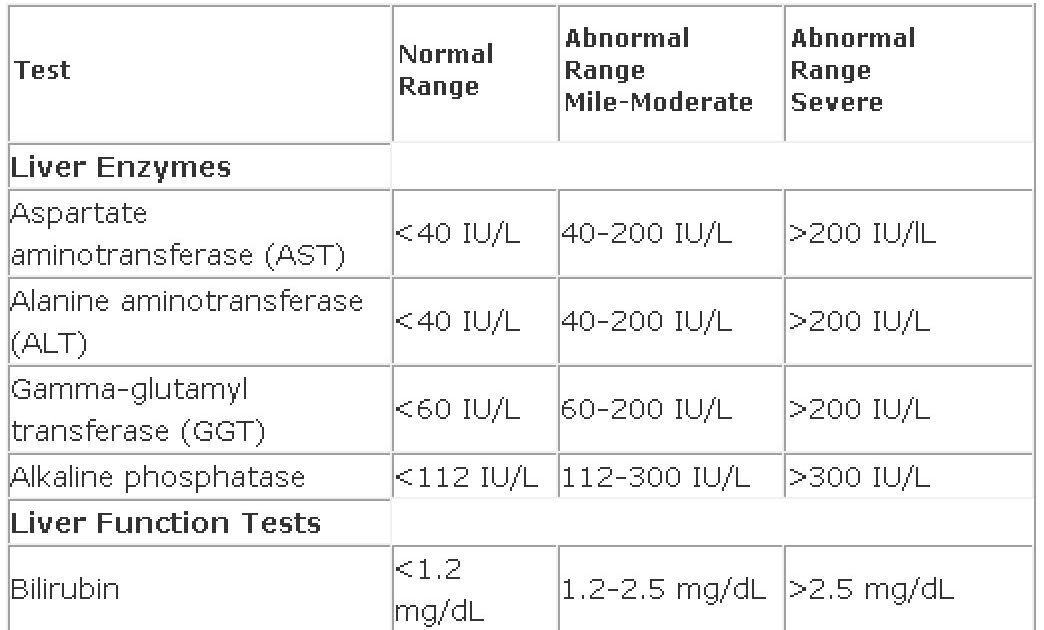
Blog Post Category:
Biological Psychiatry
You must enable JavaScript to use this form.
Your name *
Your phone number (privacy guaranteed) *
Main complaint *
Presumptive diagnosis
Taking medication
Consent to the processing of personal data *
I agree to the processing of personal data, I have read the privacy policy
Homocysteine levels and human aging
ATTENTION! THIS MATERIAL IS OUT OF DATE
Find out the latest information about homocysteine in the article: “Homocysteine Adjustment”
Homocysteine – one of the main mechanisms that cause dangerous diseases of the heart, brain and human aging in general.
Homocysteine level and human aging
The health of our heart directly depends on the amount of homocysteine in the heart muscle and blood vessels. When there is too much of it in the blood vessels, systemic inflammation occurs, and inflammation always gives rise to atherosclerosis of the vessels. It is atherosclerosis of the vessels that is the main cause of heart attack and stroke.
When there is too much of it in the blood vessels, systemic inflammation occurs, and inflammation always gives rise to atherosclerosis of the vessels. It is atherosclerosis of the vessels that is the main cause of heart attack and stroke.
There is an opinion that it is cholesterol that is “evil”, since it seems to clog blood vessels. But, as studies show, cholesterol does no harm if there is no inflammatory reaction in the vessels (read the article – “Is cholesterol in food dangerous?”). Precisely high homocysteine level is one of the main causes of systemic inflammation.
Low level of homocysteine allows:
- to maintain a good memory
- to maintain high mental and physical performance
- to slow down the rate of development of old age in the body
How to keep your homocysteine levels low :
- Homocysteine - is an amino acid that is synthesized from methionine.
 Thus, by reducing the level of methionine in the body, we can slow down the formation of homocysteine itself. The poorest methionine foods are vegetables. Eliminating all foods from your diet for two days a week, except for raw vegetables, can successfully reduce methionine levels and prevent the accumulation of homocysteine. You can read more about vegetable fasting days in the article – “Autophagy – the correct cleansing of the body.”
Thus, by reducing the level of methionine in the body, we can slow down the formation of homocysteine itself. The poorest methionine foods are vegetables. Eliminating all foods from your diet for two days a week, except for raw vegetables, can successfully reduce methionine levels and prevent the accumulation of homocysteine. You can read more about vegetable fasting days in the article – “Autophagy – the correct cleansing of the body.” - Metformin also reduces intestinal absorption of methionine.
- There are agents that allow already accumulated homocysteine to be converted back into methionine. These are vitamin B 12 and folic acid. Thus, 500 mcg of vitamin B12 separately from other vitamins (not in complexes – it is not absorbed at all in complexes) daily throughout life can effectively prevent premature human aging due to the accumulation of homocysteine.
- Vitamin B6 deficiency is also associated with hyperhomocysteinemia
Research link:
- excess methionine in the body for turning it into homocysteine, which is dangerous for humans) reduces life by 30-40%.
 Read more about this in the article – “L methionine in nutrition accelerates human aging ”
Read more about this in the article – “L methionine in nutrition accelerates human aging ”Every week new scientific research publications appear, and new means become known that allow prolonging human life and improving the quality of life. Science is developing very quickly. We invite you to become a regular subscriber to the latest articles of this scientific blog so as not to miss all the most cutting-edge news.
Leave This Blank:Leave This Blank Too:Do Not Change This:
Your email:
Dear reader. If you find the material of this blog useful and want this information to be available to everyone, then you can help promote the blog, giving it just a couple of minutes of your time. To do this, follow the link.
We also recommend reading:
- Vitamin B1 (thiamine) slows down human aging , blocking protein glycation
- Vitamin D inhibits the onset of human old age
- Glucosamine sulfate inhibits the onset of human old age
- Nicotinamide riboside or Vitamin B3 against old age
- Vitamins and longevity
9 0165 Metformin is the No.


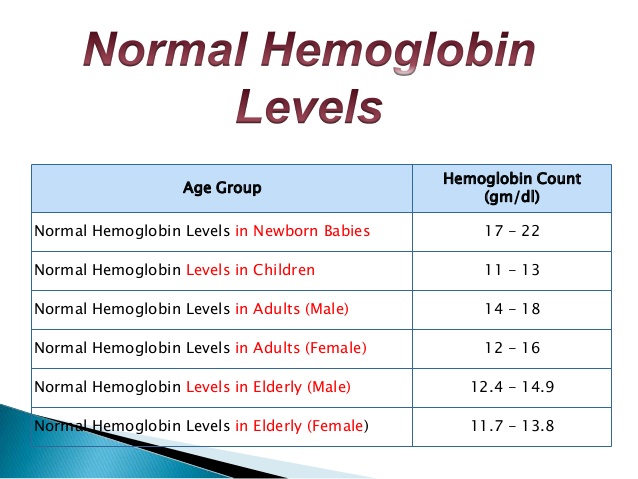 84 umol/L for all-cause death
84 umol/L for all-cause death Thus, by reducing the level of methionine in the body, we can slow down the formation of homocysteine itself. The poorest methionine foods are vegetables. Eliminating all foods from your diet for two days a week, except for raw vegetables, can successfully reduce methionine levels and prevent the accumulation of homocysteine. You can read more about vegetable fasting days in the article – “Autophagy – the correct cleansing of the body.”
Thus, by reducing the level of methionine in the body, we can slow down the formation of homocysteine itself. The poorest methionine foods are vegetables. Eliminating all foods from your diet for two days a week, except for raw vegetables, can successfully reduce methionine levels and prevent the accumulation of homocysteine. You can read more about vegetable fasting days in the article – “Autophagy – the correct cleansing of the body.” Read more about this in the article – “L methionine in nutrition accelerates human aging ”
Read more about this in the article – “L methionine in nutrition accelerates human aging ”